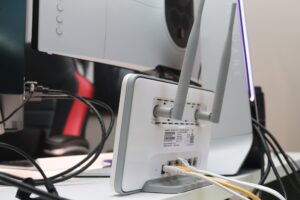
Where Did that Unknown AP Come From?

This is the tale of the unknown AP and the Wireless Intelligence Platform™ (WIP) that unmasked it. The AP thought itself clever, sneaking onto the same WiFi channel used by a nearby school’s APs and cackling to itself. It knew that it was stealing bandwidth needed by the school’s APs, and that students could experience service degradation thanks to its wily moves. What could the school do? The AP wasn’t actually connected to the school’s network, and therefore couldn’t be found by any analytics tools that only looked at that single network. All might have been lost, if not for the all-seeing, proactive Wyebot Wireless Intelligence Platform™ (WIP).
WIP revealed everything to the eyes of IT. Its AI-engine analyzed the entire wireless ecosystem, and its easy-to-use dashboard provided a list of all devices on the school’s chosen WiFi channel. Instantly, IT could see that there was one AP that did not belong.
This AP’s name? Pauline’s Car.
Yes, it was the access point in an employee’s car that thought itself so clever. But it couldn’t hide from WIP. The platform not only instantly identified the device, it revealed to IT how the AP was impacting the school’s network, and suggested a plan for resolution. With WIP, the network was once again optimized.
Okay, maybe it didn’t happen quite like that, but it did happen.
WiFi is a shared medium. This means that everything connecting to the WiFi – phones, laptops, APs, IoT devices, etc. – has to share the airwaves and take turns sending and receiving data. The more devices that connect to a WiFi channel, the more contended this airspace becomes. Trying to keep latency low as more and more devices eat up the bandwidth can become quite a challenge. It’s crucially important that companies and schools know exactly what devices are connected so that they can best manage this medium – and ensure that there are no unknown devices using the bandwidth, and causing interference and service degradation for end users.
One of Wyebot’s education customers wanted to check on this very issue, and so they went to Wyebot’s WIP and opened its dashboard. WIP provides full visibility into the entire wireless ecosystem and the dashboard provides a list of any APs in the area as well as connected devices. This includes everything on your network, as well as any devices on nearby networks. With shared airspace, the biggest challenge to a network can be airspace interference, such as APs from different networks operating on the same channel or frequency band.
So, our education customer opened up the dashboard and there was one AP on the list that the customer didn’t recognize. This AP was using the same channel as the school’s APs, which means it could have been causing interference. Needing to know more in order to know how to fix the problem, the customer used WIP’s device forensics capability to select the device and get identifying information.
This AP had a name. Pauline’s Car.
Yes, it was the car of an employee at the school. With the device identified, the school’s IT could decide what action to take to resolve the problem – for example, changing the channel used by the school’s APs if there was significant interference/service degradation caused by the AP.
This humorous situation highlights how crowded the wireless medium has become. It was a car’s AP in this instance, but it could have been APs from a nearby neighborhood, or a student’s phone acting as a hotspot. Without full visibility 24×7 into the entire wireless ecosystem, it isn’t possible to identify these sources of interference, which makes it impossible to resolve them. For a truly optimized wireless network, schools must have complete and continuous visibility, and that is what WIP provides.
WIP is vendor agnostic and provides 24/7 visibility into the WiFi ecosystem: Access Points, client devices, non-WiFi devices, and RF airwaves from all nearby networks. Its device forensics capability provides specific data and analytics for each device. Use WIP today to get the most complete look at what is impacting your network, and automatic suggestions for quick resolution.
Unknown APs beware.


